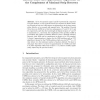Free Online Productivity Tools
i2Speak
i2Symbol
i2OCR
iTex2Img
iWeb2Print
iWeb2Shot
i2Type
iPdf2Split
iPdf2Merge
i2Bopomofo
i2Arabic
i2Style
i2Image
i2PDF
iLatex2Rtf
Sci2ools
92
Voted
AAIM
2010
Springer
2010
Springer
Efficient Exact and Approximate Algorithms for the Complement of Maximal Strip Recovery
Given two genomic maps G and H represented by a sequence of n gene markers, a strip (syntenic block) is a sequence of distinct markers of length at least two which appear as subsequences in the input maps, either directly or in reversed and negated form. The problem Maximal Strip Recovery (MSR) is to find two subsequences G and H of G and H, respectively, such that the total length of disjoint strips in G and H is maximized (i.e., conversely, the complement of the problem CMSR is to minimize the number of markers deleted to have a feasible solution). Recently, both MSR and its complement are shown to be NP-complete. A factor-4 approximation is known for the MSR problem and an FPT algorithm is known for the CMSR problem which runs in O(23.61k n+n2 ) time (where k is the minimum number of markers deleted). We show in this paper that there is a factor-3 approximation for CMSR and there is an FPT algorithm which runs in O(3k n + n2 ) time for CMSR, significantly improving the previous boun...
| Added | 02 Sep 2010 |
| Updated | 02 Sep 2010 |
| Type | Conference |
| Year | 2010 |
| Where | AAIM |
| Authors | Binhai Zhu |
Comments (0)

